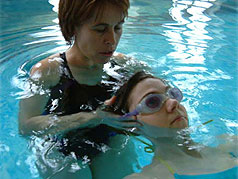"When an investigation comes to be made, it will be found that the very thing we are doing in the work is exactly what is being done in nature where the conditions are right — the difference being that we are learning to do it consciously."
FM Alexander
How does Alexander Technique apply to swimming?
In order to swim we need to balance easily in the water. If we are using inappropriate tension in our muscles this will increase muscle density. This increase in density will decrease our ability to float in the water. As we learn to release this tension we can then work with a much more bouyant body without changing anything else. The first lesson is to learn to do less and allowing the mind and body to work together. The increased understanding of how our body and mind functions together gives us a chance to learn new activities more easily. We can call it consious learning. We teach you how to glide with good alignment of your spine in the water, protecting the back from damage. This is the foundation upon which we build. Progressively adding each lesson the individual arm and leg actions required to swim.
Why change my method of swimming?
Traditional swimming methods teach a whip kick, which can cause many people knee and back problems. If you swim with the head out of the water each time you kick the legs its like causing a minor whip lash in the neck. So it is possible you may be doing more damage to your spine than you are aware of. Prolonged training times with repetitious movements may also mean that you can be building the muscles to such an extent that it will support and maintain this damage outside of the pool.
This method of swimming instruction is based on the Alexander Technique called "Shaw Method".
It teaches greater body awareness, strengthening the relationship between mind, body and water.
It promotes freedom and ease of movement, through the water.
It reduces unnecessary effort which helps to prevent unnecessary tension, strain and injury.
Who is it for?
This method is appropriate for all abilities and ages ranging from those anxious about putting their face in the water to those wishing to improve their style. It is especially beneficial for:
Improving performance & style.
Enhancing enjoyment of water.
Long distance swimming - it prevents over-exertion.
Learning relaxed breathing.
Confidence building, overcoming fear of water.
Learning new strokes.
Efficiency; reduce strokes for the distance covered.




